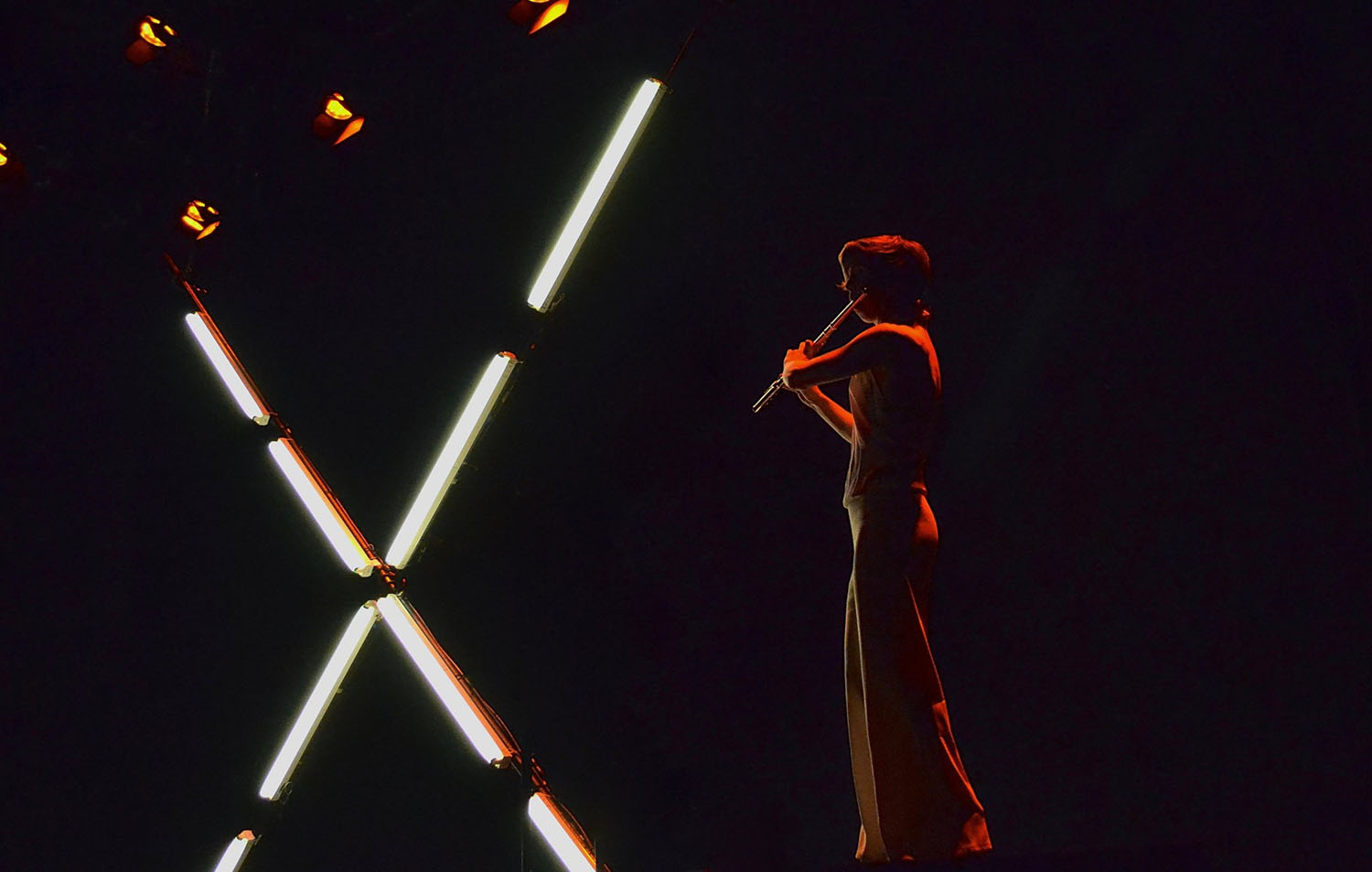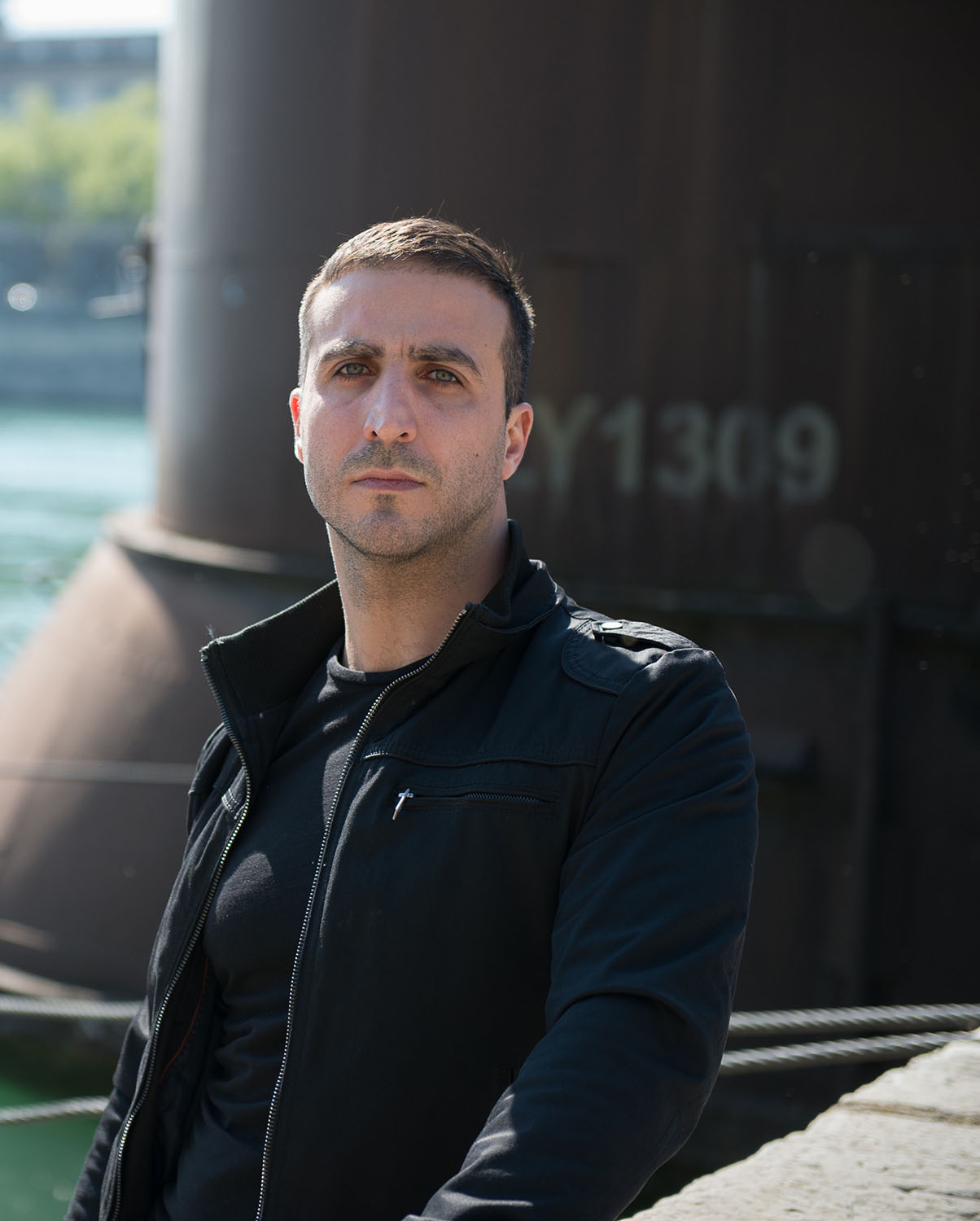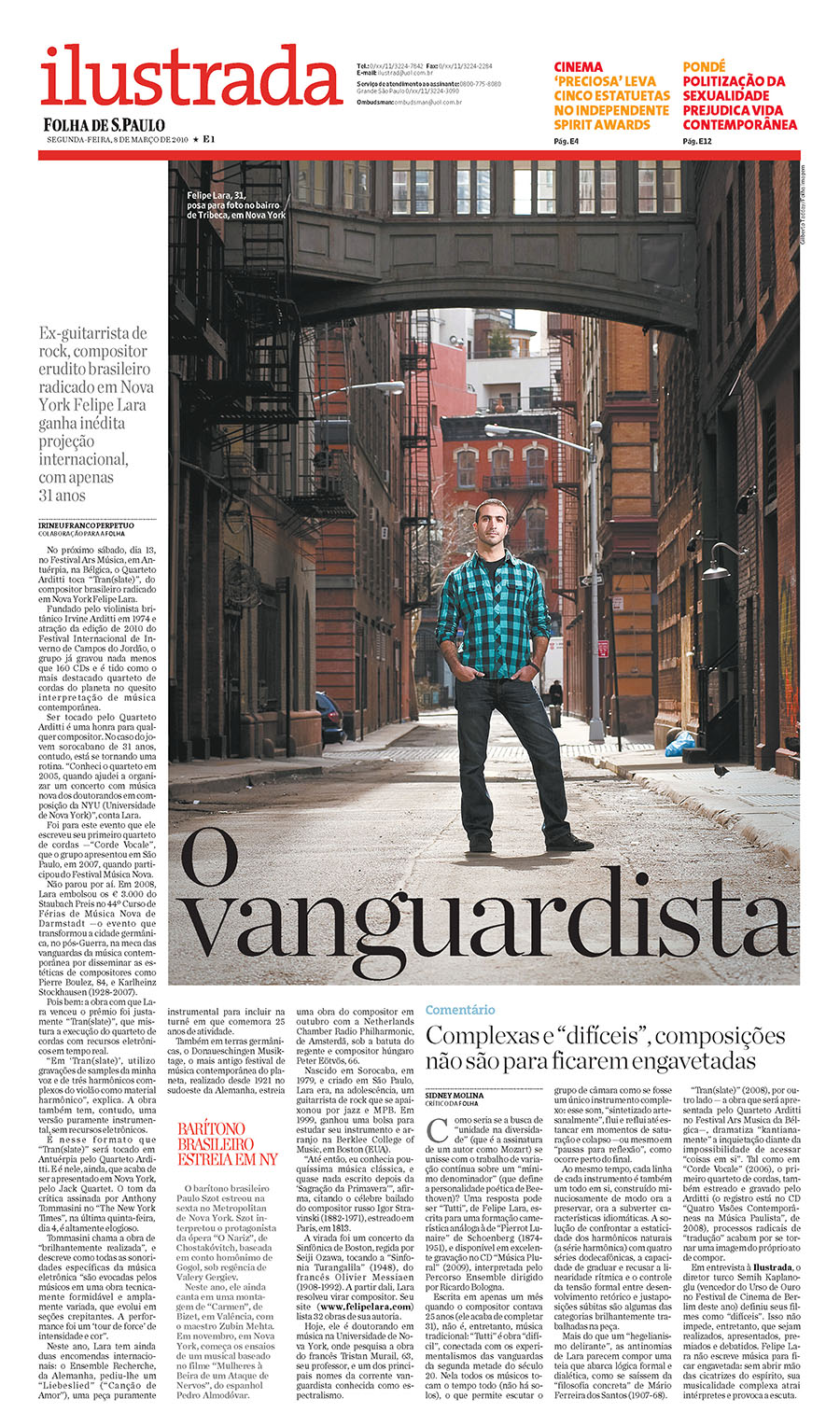 photo credit: Celeste Sloman
photo credit: Celeste Sloman
"This was one of the freshest 21st-century works one has heard, with Chase and spalding parrying with semi-improvised swoops and vocal phrases within a form that touched on abstraction but came together in rich, satisfying cadences."
— Financial Times
"Excelllent" — The New York Times
"a gifted Brazilian-American modernist" — The New York Times
"He also has the skill to shape a gorgeously varied but unbroken single movement that evolves organically over its 30 minutes to a final lullaby, pricked by starry harp. This is a complex but legible, lovable piece; a funky yet elegant ritual; thrilling and taut, if also fundamentally unhurried and unpressured. Spalding performed in a jumpsuit printed, in bold capital letters, with “LIFE FORCE,” and I felt that way about the music, too." — The New York Times

"one of our favorite up-and-coming composers" — The New York Times full article 
"a highly regarded young composer" — The Boston Globe
"brilliantly realized" — The New York Times
 photo credit: Chris Lee
photo credit: Chris Lee
“The New York Philharmonic gave some remarkable concerts this year... perhaps most notable was the New York premiere, in March, of Felipe Lara’s 2019 Double Concerto, which made Claire Chase (on many flutes) and Esperanza Spalding (vocalizing while playing double bass) into a seething and exuberant, if not always sunny, organism. (Read our review of the Lara concerto.)” full article 
"I feel altered by the landscape of Felipe’s orchestration. There’s a rush to my nervous system that I can’t quite explain. One of the challenges for me is not getting swept up in that sensation. I just want to stop and listen."
— esperanza spalding
"I don’t feel like a soloist in the piece; I’m more like a vein in the middle of a thick, undulating body.
When I used to play bass in orchestras growing up, I could feel myself on the outside of the sound being the feet of the dance. I’m placing this note here so that movement can happen. In the Double Concerto, everything I’m doing is interwoven with the orchestra, or it’s in an extemporaneous dialogue with Claire."
— esperanza spalding
“Felipe Lara’s sensational Double Concerto, exuberant if not always sunny, had its New York premiere on Wednesday.” full article 
“Felipe Lara has nevertheless made an almost comet-like career in Western art music, but do not think that his now premiered - commissioned by Helsinki Philharmonic Orchestra and Los Angeles Philharmonic – Double concerto for flute, double bass and orchestra sounds like anything else you have ever heard before.”
— Hufvudstadsbladet, Finland
"In his brilliantly realized "Tran(slate)" (2008), the composer Felipe Lara transforms an earlier work for string quartet and electronics into a completely instrumental piece. All the bleeps, rings, loops, time delays and such of electronic music are evoked by the string players in a technically formidable, wildly varied work that evolves in sputtering sections. The performance was a tour de force of intensity and color." full article
— Anthony Tommasini, The New York Times 
"A piece for string quartet, in which the processes that control the studio-generated sounds have been translated into colorful and energetic textures for the strings."
"Brazilian composer Felipe Lara is one of the very best young composers today. He combines various musical languages to create a syntax of his own. This is certainly true of his recent second string quartet, a work that can be played with or without electronics."
— Irvine Arditti (violinist, founder of the Arditti Quartet)
"Como seria se a busca de "unidade na diversidade" (que é a assinatura de um autor como Mozart) se unisse com o trabalho de variação contínua sobre um "mínimo denominador" (que define a personalidade poética de Beethoven)? Uma resposta pode ser "Tutti", de Felipe Lara, escrita para uma formação camerística análoga à de "Pierrot Lunaire" de Schoenberg (1874-1951), e disponível em excelente gravação no CD "Música Plural" (2009), interpretada pelo Percorso Ensemble dirigido por Ricardo Bologna."
[English Translation]
"How would it be if the serach of a "unity in diversity" (which is the signature of an author like Mozart) was combined with one of continuous variation on a "common denominator" (that better defines the poetic personality of Beethoven)? One answer could be "Tutti", by Felipe Lara, written for a chamber combination analogue to Schoenberg's "Pierrot Lunaire" (1874-1951), and available in an excelent recording in the CD "Música Plural" (2009), here interpreted by the Percorso Ensemble, and conducted by Ricardo Bologna."
— Sidney Molina, Folha de São Paulo
"Felipe Lara não escreve música para ficar engavetada: sem abrir mão das cicatrizes do espírito, sua musicalidade complexa atrai intérpretes e provoca a escuta."
[English Translation]
"Felipe Lara doesn't write music to stay in cabinets: never letting go of the scars of the spirit, his complex musicality attracts performers and teases the very act of listening"
— Sidney Molina, Folha de São Paulo
"Im Abendkonzert am Donerstag in der Orangerie verschmilzt in Laras zweitem Streichquartett "Tran(slate)" die Elektronik auf raffinierte Weise mit dem Instrumentalensemble. Lara hat kurze akustische Schnipsel, bestehend aus wenigen gesummten Tönen, digital verarbeitet, um musikalische Informationen zu erhalten. Diese transformiert er zu den Motiven des Quartettsatzes. Die Klänge wandern, ausgehend vom Streichquartett auf der Bühne, in fließenden Prozessen mit den elektronischen Einspielungen durch den Raum. Hier wird auf schlüssige Weise Neues geschaffen, das mit alten Traditionen des Genres bricht."
[English Translation]
"In the evening concert on Thursday, in the Orangerie, the electronics and the instrumental ensemble coalesced in a refined manner. Lara had short acoustic snippets comprising of a few hummed tones, which were digitally processed for the computer to store. These transformed the motives and phrases from the string quartet. The sounds wandered, outwards from the string quartet on the stage, in real-time processes with the electronic sounding in different places throughout the room. Here new invention and old tradition collapsed convincingly."
— Von Marius Volz, Darmstädter Echo

"Felipe Lara (b.1979) managed to gain coherency by presenting and then uniting many diverse elements. In Lara's work, a kaleidoscopic unity was arrived at by the contrapuntal juxtaposition of its myriad sonic effects."
— Patrick Valentino, Classical Voice of New England
"Poucas semanas atrás foi a vez de Felipe Lara, agraciado com Prêmio Staubach, que além de alguns milhares de euros, lhe rendeu também a encomenda de uma nova obra a ser estreada pelo conceituado Arditti String Quartet no mítico festival de verão de Darmstadt, na Alemanha. Prêmios como estes são apenas a ponta de um iceberg, não só na carreira destes compositores, mas de toda uma geração."
[English Translation]
"A few weeks ago was Felipe Lara's turn, granted the Staubach Prize, which apart from the award, provided him with a new commission, which (as a finalist) was premiered by the respected Arditti Quartet in the legendary summer festival of Darmstadt, Germany. Prizes like these are only the tip of the iceberg, not only in these composers careers, but for an entire generation."
— Leonardo Martinelli, Revista Concerto, Brazil

 Claire Chase
Claire Chase
"Felipe Lara's Meditation and Calligraphy and Parábolas na Caverna had particularly fluttering, ricocheting flute lines" full article
— Zachary Woolfe, The New York Times 
"The pieces we heard on Wednesday night were selections from parts i, ii, iii (2013-2015), beginning with two compositions by Felipe Lara, Meditation and Calligraphy (2014) for solo amplified flute, and Parabolas na Caverna (2014) for solo amplified flute. From the opening notes, it's apparent we're in for an uncommon, provocative, experimental performance.
Chase puts her whole body into her music, and the flute becomes a vast range of percussive and melodic instruments in her hands. She spits, vocalizes, aspirates, thumps and pops into the mic'd mouthpiece, creating a cacophony that jars and teases, surprises and delights. Chase seems determinate to push the boundaries of the flute, reaching into uncgharted territory."
— Cicely Binford, Perth Arts Review (Australia)
"The first is Meditation and Calligraphy (for G. Mend-Ooyo) (2014) by Felipe Lara. Chase emerges from behind a black curtain into the mostly dark space, finding her place on a stool under a narrow spotlight. Here, she begins to calmly and decisevely breathe sound through a golden bass flute tha shimmers likea sunset as she slowly sways. The notes are spare and rustling, as patient and nonchalant as a breeze, until suddenly she lets fly a pair of wild staccato stabs, semewhere between a note and a violent sneeze. This contrast leads into a textured polyphony - two notes somehow emerging at once - then key noise and a low growl, a gurgling contemplation, something akin to a horse's snort. And on it goes, sounds emerging as discrete utterances, suggesting less a narrative and more a unity of mood and purpose. Lara wrote the piece quickly after meditating for an evening, inspired by the stately calligraphic gestures of Mongolian poet G. Mend-Ooyo whom he'd met in Umbrian castle. It's a great backstory but, more importantly, it actually translates: each note, whispy phase and near-tactile vibration floats with the assuredness of ink swooshed clean on paper.
Another Lara commission, Parábolas na Caverna (2014) follows. Again, this is very much flute laid bare - no backing tracks, no effects to speak of. Given the simplicity of this arrangement it's tempting to describe it as "minimal" bit - on the contrary - Case conjures a dizzying array of pitches, timbres and dynamics. The percussive tonguing of raindrop-like notes about a minute in is the first sound of the night that I feel I've never quite heard before. The piece also ventures into hectic cacophony, pitchless squeels and aquatic burbles. But its overall impression is its real triumph: a carefully hewn yet somehow formless rhapsody, inspited by Plato's cave and its compelling but ungraspable shadows of reality.
— Cool Perth Nights (Australia)
 Felipe Lara Composer Portrait at Miller Theatre
Felipe Lara Composer Portrait at Miller Theatre
"Ms. Heller also performed Felipe Lara’s vivid Metafagote that evening, playing through its lead part over six prerecorded tracks." — The New York Times 
"Felipe Lara's "Metafagote"(2015) rearranged my understanding of an instrument rarely in the spotlight, ever the orchestra's bridesmaid.
Like Luciano Berio's genre-defying "Sequenza XII" (1995), for the same instrument, Mr. Lara's work is self-referential, about the bassoon itself.
Or, rather, it's about bassoons, as the work surrounds the soloist with prerecorded sounds of six other soloists, foreshadowing the live artist, challenging her, admiring her and interracting with her. It might have been an odd comment, as if to say that solo bassoon needs to talk to others to communicate anything meaningful, had the palette that Mr. Lara demands - and received - from Ms. Heller not drown still further attention to the instrument's possibilities. — The New York Times full article

 photo credit: Rolex/Hugo Glendinning
photo credit: Rolex/Hugo Glendinning
"An alluring array of sounds filled St. Paul's German Lutheran Church in Manhattan on Tuesday during a performance of Brazilian-born composer Felipe Lara's Voz dos Ventos (Voice of the Winds)...The lights were dimmed as what sounded like a chorus of deep breathers echoed through the church. It seemed as if more than three instruments were at work as unearthly timbres blended in a microtonal mash, the music flowing and ebbing in intensity as the low rumblings of the bassoon underpinned the bright sound of the flute." — The New York Times

"Lara's two pieces, Livro dos Sonhos for clarinet and piano and Voz dos Ventos (a world premiere) for amplified flute, clarinet, and bassoon, exude energy. The instruments spar, interrupt and mirror each other and, at times, come together in mutual agreement. There are shrieks and slides, hissing, flutter-tonguing and almost percussive sounds that stretch the limits of instrumental possibilities. But throughout all this, Lara manages an internal architectural logic that shapes a curve from beginning to end."
— The Washington Post
"An alluring array of sounds filled St. Paul's German Lutheran Church in Manhattan on Tuesday evening during a performance of the Brazilian-born composer Felipe Lara's "Voz dos Ventos" ("Voice of the Winds"), part of the imaginative Chelsea Music Festival. Mr. Lara advised the audience not to turn around and watch the clarinetist Danny Goldman, the flutist Caitlyn Phillips, and the bassoonist Brad Balliet as they played in a balcony at the back of the church, but to focus instead on how the music traveled in space.
The lights were dimmed as what sounded like a chorus of deep breathers echoed through the church. It seemed as if more than three instruments were at work as unearthly timbres blended in a microtonal mesh, the music flowing and ebbing in intensity as the low rumblings of the bassoon underpinned the bright sound of the flute." — The New York Times full article

"Lara's two pieces, Livro dos Sonhos for clarinet and piano and Voz dos Ventos (a world premiere) for amplified flute, clarinet, and bassoon, exude energy. The instruments spar, interrupt and mirror each other and, at times, come together in mutual agreement. There are shrieks and slides, hissing, flutter-tonguing and almost percussive sounds that stretch the limits of instrumental possibilities. But throughout all this, Lara manages an internal architectural logic that shapes a curve from beginning to end."
— The Washington Post

"Lara é mesmo um nome em ascenção no campo da música contemporânea"
[English Translation] "Lara is indeed a name in ascension in the field of contemporary music"
— Debora Ghivelder, O Globo full article
 photo credit: Rolex/Hugo Glendinning
photo credit: Rolex/Hugo Glendinning
"In the unboxed first night of the festival, in which Adès conducted the L.A. Phil and appeared as pianist in a post-concert recital with violinist Pekka Kuusisto, no two works or composers were alike. That could mean the invigoratingly direct orchestral stomping of Anna Meredith’s “Nautilus” or the distorted musical symmetries Felipe Lara’s Brutal Mirrors inspired by Mauro Restiffe’s photographs of Soviet Russia architecture." — Los Angeles Times
"flamboyant, ever-surprising"
"a gifted Brazilian-American modernist"
— Steve Smith, The New York Times 
"Felipe Lara's Corde Vocale, stuck me as the piece most likely to gain entry into the Arditti repertoire: an introductory stretch of stabbing thrusts, stitched together with the most tenuous of sonic threads, gave rise to a series of tonal chords made all the more startling by context. A transition of sine-wave stillness led to an agitated conclusion. The horsehair-ripping physicality of Lara's piece announced a bold, distinctive voice, presented with stylistic confidence and technical assurance." full article
— Steve Smith, TIME OUT New York
"Tanto melhor que o programa de anteontem, fechando a programação do Festival Música Nova, trazia outras obras bem recentes, incluindo a música de dois brasileiros, Felipe Lara(1979) e Alexandre Lunsqui (1969). "Corde Vocale", do sorocabano Felipe Lara, foi composto no ano retrasado. As "cordas vocais" do título são metáforas para as vocalizantes cordas do quarteto, que se comunicam irregular e contrapuntisticamente, numa nebulosa sonora. Doutorando em composição na Universidade de Nova York, sob orientação de Mario Davidovsky, Louis Karchin e Tristan Murail (Columbia), Lara escreve num idioma que conversa com a eletroacústica e a música espectral, mas aponta para outra direção."
[English Translation] "So much so that the program, wrapping up the festival, also brought brand new works, including two Brazilians, Felipe Lara(1979) e Alexandre Lunsqui (1969). Lara's "Corde Vocale" was composed two years ago. The "vocal chords" from the title refers to metaphors of vocalizing strings from the quartet, which communicate irregularly and contrapuntaly in a sonic cloud. Currently a PhD candidate at New York University under the supervision of Mario Davidovsky, Louis Karchin, and Tristan Murail (Columbia), Lara writes in an idiom which converses with electroacoustic and spectral music, but points at a rather different direction." full article
— Arthur Nestrovski, Folha de São Paulo

